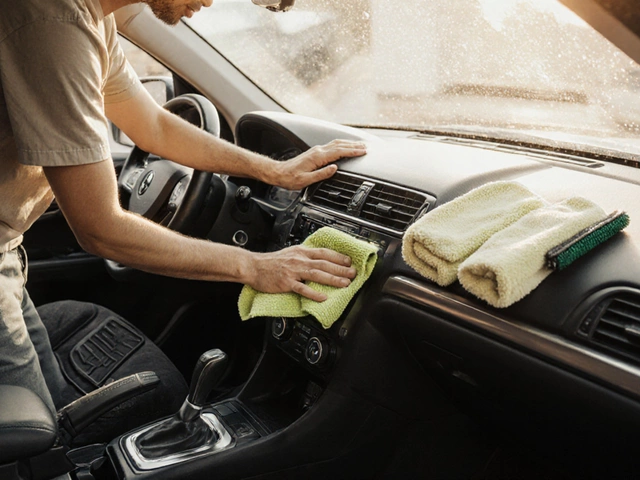Wheel spacers get a lot of attention in the car world, but a lot of folks aren’t sure if it’s smart to run them on their daily driver. If you spend hours behind the wheel—commuting, running errands, basically living in your car—you want to know if spacers are actually a safe move or just a style thing.
Here’s the simple truth: wheel spacers push your wheels out from the hub, making your car look wider and sometimes letting you fit bigger brakes or clear suspension parts. But there’s more to it than just looks. They change how the car handles, how fast parts wear out, and even how your ride feels on rough roads. People use them to give their wheels that aggressive “flush” look, but daily life with spacers means paying attention to things like vibrations, torque settings, and even the laws in your area.
If you’ve been thinking about running spacers every day, you’ll want real, clear info on risks and rewards—not just random opinions from car forums. Let’s get into what actually changes when you bolt spacers onto your car and how to keep everything safe and smooth if you make that call.
- What Are Wheel Spacers and Why Use Them?
- Daily Driving: Pros and Cons
- Safety, Maintenance, and Longevity
- Tips Before You Make the Swap
What Are Wheel Spacers and Why Use Them?
Wheel spacers are simple metal discs, usually made from aluminum or steel, that fit between your car’s wheel hub and the wheel itself. By adding thickness, they push your wheels outward. This changes the wheel spacers’ offset and track width, giving your ride a wider stance.
People use wheel spacers for a few solid reasons. First off, they help your wheels sit “flush” with the fenders. That means no more sunken-in factory look. Second, spacers can help clear aftermarket brakes or suspension setups, which often don’t fit inside stock wheel wells. If your wheels rub on the struts, spacers push them out just enough to stop the problem. They also let you run different offset wheels without swapping out your whole wheel set.
Some drivers just like the look—a wider stance feels more ‘planted’ and changes the whole vibe of a car. Track guys sometimes use them to increase stability during cornering since a wider track can improve grip. It’s not magic, but it’s a noticeable change when you’re pushing the car hard.
Not all spacers are created equal. They come in different thicknesses—from 3mm (barely anything) all the way up to 50mm (that's two inches or more). Here’s a quick comparison:
| Thickness (mm) | Common Use | Potential Impact |
|---|---|---|
| 3–5 | Minor fitment fixes | No major changes in handling |
| 10–15 | Flush look, clears brakes | Slightly wider feel, may need longer studs |
| 20–50 | Major stance, extreme fitment, lifting trucks | Noticeable impact on handling and bearing wear |
There are two main types of spacers: ‘slip-on’ (which slide over the hub and need longer studs) and ‘bolt-on’ (which bolt to the hub and give you their own set of studs). Picking the right one depends on your wheel setup and how big of a spacer you need. Just remember, cheap cast spacers from big-box stores can crack—they’re not made for daily driving abuse. Stick with quality, brand-name stuff if you want yours to last.
In the end, wheel spacers offer a quick way to solve fitment headaches, pull off a wider look, and even tweak how your car handles. But like any modification, it’s smart to understand exactly what you’re changing before you commit.
Daily Driving: Pros and Cons
Most people add wheel spacers because they like how their car looks with a wider stance, but daily driving with them isn’t just about style. You really have to think about how spacers change your ride day in, day out.
Here’s what you get on the plus side:
- wheel spacers can help your wheels clear bigger brake kits or coilover suspensions. No more rubbing on fenders or suspension arms—handy if you’ve got aftermarket parts.
- They let your wheels sit flush with your fenders, which isn’t just for looks. Sometimes, it actually helps with cornering by widening your car’s track a little, giving you a more planted feel in turns. People notice their steering gets a little more direct, especially on twisty backroads.
- If you’ve got a set of wheels with an offset that’s just a bit off for your car, spacers can save you from having to buy a whole new set.
That said, there’s a tradeoff. Everyday driving means potholes, speed bumps, and sudden stops. Here’s where spacers can throw a wrench into things:
- Pushing your wheels out means you’re adding weight to the end of your axle. That’s extra stress on your wheel bearings, hub, and suspension. Over time, especially if your spacers are thick (like over 15mm), you could see those parts wear out quicker.
- Some folks feel more vibration in the steering wheel, especially if the spacers aren’t perfectly hub-centric. It gets annoying fast on rough city roads or long highway drives.
- Check your local laws—some states and countries don’t allow modified wheel setups. You don’t want a ticket for something as simple as spacers.
- If they aren’t installed and torqued right, the bolts could loosen up. Regularly re-torque your lugs after installing spacers, and watch out for any knocking or clunking sounds.
For daily use, the key is quality. Cheap, no-name spacers lead to trouble. Go with a trusted brand, stick to reasonable thickness, and make sure the fitment lines up with your car. If you’re not comfortable doing it yourself, have a pro install them—the peace of mind is worth it.

Safety, Maintenance, and Longevity
Here’s where most folks start worrying: are wheel spacers safe for daily use, and do they wear out your car faster than normal? The simple answer is yes, they can be safe—if you use the right kind and install them correctly. But like any car mod, there’s stuff you can’t ignore if you want to stay out of trouble.
First, think about the basics. Quality matters a ton. Cheap, unbranded spacers you find online can be made from soft metal or drilled wrong—those are risky and can cause a wheel to wobble or even fall off. Always go for spacers made from heat-treated aluminum or billet steel, and check for proper hub-centric fit (meaning the spacer fits snug against your car’s hub, just like the factory wheel would).
Bolting on good spacers is just the start. You’ve got to re-torque the lug nuts after about 50-100 miles. A lot of people skip this and end up with vibrations or loose wheels. It only takes a few minutes, and it’s a must for daily driving.
Using spacers can put extra stress on parts like wheel bearings. They shift the load further out, so bearings and studs may wear out sooner if you go too wide (say, over 25mm per side). Here’s a quick look at how spacing affects wear:
| Spacer Width | Impact on Bearing Wear | Common Use |
|---|---|---|
| Under 15mm | Minimal, similar to stock | Flush or close to flush setups |
| 15-25mm | Moderate increase, check bearings yearly | More aggressive stance |
| Over 25mm | Noticeable increase, bearings and studs may wear faster | Extreme fitment, off-road |
Daily driving with spacers also means checking them during regular maintenance. Pop the wheels off every oil change, inspect for cracks or chips, and spin each wheel to feel for weirdness in the bearings. If you ever hear clunks or feel vibrations you didn’t have before, get things checked right away.
And don’t forget the law—some places have tight rules on how far wheels can poke out. If you get pulled over, you might face a ticket or have to pull your car off the road. Check your local vehicle codes before going wide.
At the end of the day, running wheel spacers isn’t risky if you use smart habits: get quality parts, install them right, re-torque, and keep an eye on wear. Stay on top of things, and your ride can look sharp without turning into a hassle.
Tips Before You Make the Swap
Before you throw on a set of wheel spacers for daily driving, you’ve gotta know what you’re actually getting into. There’s more to it than just grabbing a random set online. Get this wrong and you can chew through bearings, toast your alignment, or even lose a wheel—no joke. Here are some things you seriously want to check out first.
- Get the Size Right: Don’t just eyeball it. You need the exact bolt pattern, hub bore, and thickness for your car. Most passenger vehicles use 3-15mm for a subtle push, while trucks go up to 25mm or more. Too wide and your tires might rub on your fenders, especially on bumps.
- Go Hub-Centric, Not Lug-Centric: Hub-centric spacers match your car’s center hub so the weight sits on the hub, not the studs. This stops vibrations and keeps things tight. Lug-centric spacers can cause shakes at highway speed.
- Use Quality Parts Only: If the set is super cheap compared to others, that’s a red flag. Go for spacers made from forged aluminum. Avoid no-name brands that cut corners or skip quality control, which is way more common than you’d think.
- Check Legal Stuff: In the US, states like Pennsylvania and Hawaii specifically ban wheel spacers for street use, and a few other states have weird grey areas. In Europe, many countries require TUV-certified parts (a strict safety standard). Check your local rules before making the swap, or you might run into ticket problems during inspections.
- Re-Torque Regularly: After installation, drive 25–50 miles and then re-torque the bolts. Spacers can settle or loosen a bit at first. Set a reminder to check them every oil change just to be safe.
For the data nerds, here’s a comparison table about common spacer thickness and their effects:
| Spacer Thickness (mm) | Common Use | Potential Issues | Positive Results |
|---|---|---|---|
| 3-5 | Minor clearance or looks | Usually no big issues | Fixes slight rub, OEM-like ride |
| 10-15 | Flush fitment, clear small brakes | Possible fender rub on turns | Wider stance, better stability |
| 20-25+ | Trucks, aggressive stance | Faster bearing wear, legal grey area | Much more aggressive look, fits fat tires |
And a quick tip: always double-check your lug nuts for torque using a real torque wrench—not just your hand or an impact gun. Over-tightening can strip threads, while not enough can mean disaster. Small details like this keep your daily driver safe while running spacers.






